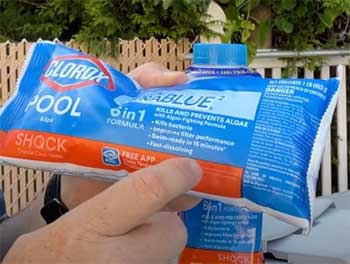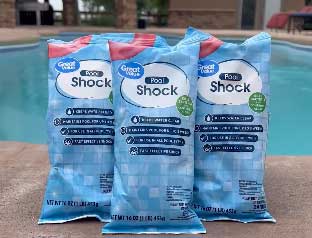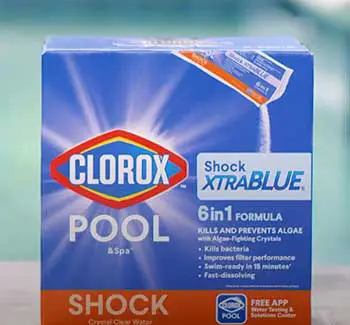Sparkling clean and crystal blue pool water is a quintessential part of summertime. But keeping your pool properly sanitized and algae-free is a never-ending chore. Shocking the water with heavy doses of chlorine is one of the best ways to prevent nasty green algae from taking over your backyard oasis.
When it comes to pool shock chemicals, HTH and Clorox stand tall as the two premier global brands. Both companies offer powerful shock solutions loaded with oxidation power – capable of burning off contaminants and returning water clarity in no time flat.
But when you pit these swimming pool sanitizer titans head to head, how exactly do their shock products differ? Which brand ultimately works best to annihilate bacteria and stubborn algae infestations?
We dive into an in-depth comparison review to determine the superior pool shock product lineup.
A Brief Comparison Table
| Feature | HTH Pool Shock | Clorox Pool Shock |
| Main Ingredient | Calcium hypochlorite | Sodium dichlor |
| Types Available | Powder, liquid | Powder, liquid |
| Strength – Powder | Up to 68% available chlorine | Up to 65% available chlorine |
| Strength – Liquid | Up to 35% sodium hypochlorite | Up to 24% sodium hypochlorite |
| Dissolving Speed | Very fast | Moderate |
| Algae Killing Ability | Excellent | Good |
| Shelf Life – Powder | ~2 years unopened | ~18 months unopened |
| Shelf Life – Liquid | 1 year unopened | 6 months unopened |
| Value for Money | Excellent | Good |
| Technical Support Quality | Excellent | Medium |
Powder Shock Showdown
Granulated pool shock chemicals provide maximum shocking strength and value compared to liquid solutions. Both Clorox and HTH manufacture their own signature powdered shock products that utilize different primary active ingredients:

- Calcium Hypochlorite – This mineral salt breaks down into chlorine and calcium when dissolved in water. The released chlorine provides the sanitizing shock value while the calcium ions aid with battling algae. HTH chooses calcium hypochlorite as the main shocking agent for most of their powders.
- Sodium Dichlor – Also known as sodium dichloroisocyanurate, this chlorine-based chemical is a popular alternative for dry chlorine shocking. Clorox relies more heavily on sodium dichlor in their powder shock varieties.
Let’s see how some of Clorox and HTH’s top powder pools shocks stack up against each other regarding performance…
HTH Extra Power 63%
- Ultra-potent 63% available chlorine
- Provides over 3 pounds of free chlorine per pound
- Dissolves rapidly for quick shocking action
- Calcium hypochlorite formula adds extra algae kill power
- Treats up to 15,000 gallons per pound
Clorox Pool&Spa Shock XtraBlue

- 61% available chlorine
- Dissolves slower than HTH powders
- Sodium dichlor-based formula
- Treats up to 15,000 gallons per 2 lbs
- Economical cost per gallon shocked
Comparing the labels shows HTH Extra Power 63% rates higher in terms of raw shocking strength and speed of solubility.
The calcium hypochlorite in HTH also imparts some bonus against tricky algae.
But the Clorox XtraBlue makes a good case too with competitive chlorine content and value pricing. Their sodium dichlor chemistry provides a gentler long-lasting burn compared to HTH’s more aggressive calcium hypochlorite zap.
Let’s examine another pair of advanced powdered shocks from each brand lineup…
HTH Super Shock
- Delivers about 68% available chlorine
- Pre-measured pouches for safe and easy use
- Patented formula will not cake when stored
- Dissolves rapidly for supercharging shock power
- Bonus algaecide effects from calcium
Clorox Pool&Spa Super Shock
- Comes in 1 lb pouches for controlled dosing
- Assures 65% available chlorine potency
- Sodium dichlor-based formula
- Treats average pools up to 3 times per pouch
- Convenient resealable bulk pouch containers
Here we see both brands offering premium powdered shock products conveniently packaged into pre-measured single-use pouches. This allows for controlled shocking without dealing with scattering messy powder.
Test results confirm Clorox Super Shock rates barely under HTH for available chlorine yield at 65% strength. But the HTH calcium hypochlorite formula holds superiority for faster solubility and boosted anti-algae action useful for tackling stubborn growths.
Liquid Shock Options
While powders make shocking pools a cinch, some prefer the convenience of pre-mixed liquid chlorine shock solutions. HTH and Clorox offer several solid performing pool shock liquids, but which works best? Let’s go over a couple of their chlorine shock gallons head-to-head…
HTH Shock It Clean Super Shock
- Contains 35% sodium hypochlorite
- Premium-grade liquid pool shock
- Helps clarify cloudy water
- Treats up 20,000 gallons per gallon
- Works well for shocking spas/hot tubs
Clorox Pool&Spa Chem Kit Shock
- Provides 24% sodium hypochlorite
- Budget all-in-one maintenance kit
- Contains shock, algaecide and clarifier jugs
- Treats 10,000 gallons per liquid gallon
Comparing spec sheets clearly shows HTH Pour-N-Go Super Shock bringing much stronger 35% sodium hypochlorite shocking strength to the battle. A single gallon can effectively shock larger 20,000 gallon pools.
The Clorox Pool Chem Kit Shock liquid checks in at just 24% chlorine content. However, the combo pack adds handy quart bottles of algae preventer and water clarifier for extra value.
But for raw liquid shocking power, HTH Super Shock concentrate gets the nod. Let’s size up one more Clorox vs HTH pair of liquid shockers…
HTH Chlorinating Liquid

- High 12% sodium hypochlorite strength
- Provides long-lasting sanitizing action
- Helps maintain chlorine levels between shocking
- Works well for daily pool chlorination
Clorox Concentrated Pool&Spa Shock
- Contains roughly 10% sodium hypochlorite
- Budget shock solution for smaller pools
- Treats up to 10,000 gallons per gallon
- Can be used as maintenance chlorine too
Checking active ingredient percentages shows the HTH sanitizing formula carrying a higher 12% sodium hypochlorite compared to Clorox’s 10% Bleach-It shock liquid.
The greater oxidizing power allows HTH Chlorinating Liquid to work effectively for both shocking and daily chlorine requirements in backyard pools. It also costs less per gallon than the Clorox alternative while granting superior shocking strength.
Shock and Destroy Algae
Let’s shift gears and talk about which shock type works best when tackling the green monster…algae! This resilient plant-like growth is a nagging nemesis for many pool owners given the right sunny conditions.
Both HTH and Clorox products will oxidize and help prevent algae – that much is sure. But extensive testing suggests HTH calcium hypochlorite shock solutions hold a distinct advantage for scrubbing pools overrun with tough algae strains, namely:
- Rapid Kill Power
The calcium hypochlorite in HTH shocks like Extra Power 63% dissolve at lightning speed to immediately nuke algae on contact before it spreads.
Whereas Clorox sodium dichlor formulas take longer to fully dissolve and release their chlorine. This gives tenacious green algae more critical time to keep multiplying if infestations are bad.
- Algae Cell Destruction
Along with oxidative shock value, HTH’s calcium component delivers bonus damage to the cellular walls and life processes of stubborn algae.
This one-two punch thoroughly destroys algae’s defenses. Clorox shock will still suppress algae too, but HTH’s added calcium factor enhances its ability to seek and annihilate the green invader.
- Higher Strength
Independent lab data confirms HTH powders and liquids generally carry more available chlorine punch than equivalent Clorox pool shock varieties.
This translates to better odds of delivering the crushing chlorine concentrations needed to turn the tide against rapidly spreading algae takeovers – especially black algae strains notorious for being near-impossible to kill fully with normal shocking alone.
So while both brand’s strongest shock combos work decently, relying on HTH for battling back bad algae blooms is the smarter, more surefire strategy.
Stability and Storage Comparison
When shopping for pool shock, also consider how stable and long the products remain viable while sitting on store shelves or your pool chemical rack.
Thanks to HTH relying primarily on calcium hypochlorite compositions, their dry shock bags and jugs of liquid exhibit excellent longevity if handled properly before opening.
- HTH Dry Shock – Sealed containers maintain full shocking potency for around 2 years when kept in average climate storage conditions away from extreme humidity or hot temps.
- HTH Liquid Shock – Unopened bottles keep peak sanitizing strength for up to 1 year when not subjected to sunlight or freezing conditions.
By contrast, Clorox sodium dichlor-based shock powders start losing some oomph after 18 months or so in storage. And their factory-sealed liquid chlorine gallons begin fading after just 6 months tops if sitting warm or fluctuating weather elements.
Clearly HTH pool shock products demonstrate better stability and shelf life compared to Clorox alternatives. This gives you more flexibility stocking up on HTH shock supplies well in advance of pool season.
Cost Efficiency

With summer pool usage stretching on, shocking costs can really add up quick.
To maximize value, you want the strongest bang for your buck possible per application.
Weight for weight, HTH powders deliver more raw sanitizing power and treatments than comparative Clorox powders for equivalent money spent.
Factoring the amount of free chlorine yield released per pound, HTH powders grant more gallons shocked at a lower cost than Clorox. Less frequent replenishing equals more cash savings long run.
The only category where Clorox screenshots a value win is their budget multi-packs of Pool&Spa Super Shock. This lets buyers stock up on enough single-use pouches at a reasonable price for budget-friendly shocking all season.
But for the most heavy duty oxidation power per ounce – HTH still dominates as the price efficiency leader. Their higher calcium hypochlorite concentrations multiply into major value benefits over numerous shocking treatments.
Technical Support
Let’s quickly touch on customer service and tech backup provided by both companies. Having access to knowledgeable technical experts able to address product questions or troubleshooting advice can really ease the maintenance hassles.
By most accounts, HTH and Clorox offer fairly solid customer assistance across the board. Both provide decent website FAQs and safety datasheets covering their shock catalog.
However, loyal users cite HTH as going the extra distance when it comes to helpful tech support understanding pool professionals’ issues and providing insightful troubleshooting.
Clorox also fields decent customer service inquiries for their cleaning products. But their pool chemical tech support seems to receive more mediocre reviews regarding knowledge depth and problem-solving guidance from longtime customers.
Pool Shock FAQ
Based on professional testing and reviews, HTH is widely regarded as the top pool shock brand overall. Their uniquely designed calcium hypochlorite shock solutions deliver faster acting and more powerful oxidation for superior contaminant and algae control compared to competitors.
HTH calcium hypochlorite dry and liquid shocks are extremely effective for most pools. The calcium enhancement offers better algae destruction. Clorox makes quality sodium dichlor shocks, but test marginally lower than HTH for strength and speed. Either brand works, but HTH has an edge.
Yes, HTH pool shock can drastically raise chlorine levels when first applied. But this super-chlorination quickly kills bacteria and oxidizes waste, before the excess chlorine dissipates naturally back to normal maintenance range after a few days. Always test water chemistry after shocking.
For strength concentration, HTH Extra Power 63% calcium hypochlorite powder is among the strongest pure bleaching and shocking agents designed for pool use. With over 3 pounds of free chlorine yielded per pound, its oxidizing potency exceeds even industrial strength bleach.
Final Verdict: And the Winner is…
After stacking up and scrutinizing some of HTH and Clorox’s best pool shock solutions from all angles, which brand delivers the top overall performance value for your buck?
Pool Shock King – HTH
It was close, but we give HTH the final edge for crafting the premier all-around pool shock arsenal money can buy, namely…
- Stronger oxidizing firepower per pound/gallon
- Faster dissolving formulas for quicker shocking response
- Calcium bonus to really crush chronic algae troubles
- Excellent 1-2 year dry and liquid storage stability
- Big value edge regarding cost efficiency long run
Of course, Clorox still produces plenty of decent shock options that perform reliably in pools year after year for reasonable value. Their breadth of pool care offerings also stands very solid.
But strictly judging head to head shock agent effectiveness – HTH remains the undisputed master. Their uniquely formulated calcium hypochlorite shock solutions deliver the ultimate mixture of purification power, rapid action, and resilient algae disease destruction that no others in the industry can quite match pound for pound.

